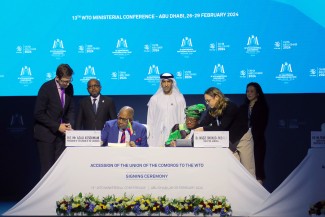|
|
|
Headlines associated with tourism and COVID-19 are alarming. The pandemic has been called an existential threat to the industry. The cruise sector has been blamed for spreading the virus. Workers in popular destinations are sliding into poverty.
Preliminary data shows the damage. Estimates indicate the number of international travellers fell by 56%, with US$320 billion in lost receipts through the end of May.
While recent shocks wreaked financial havoc, this disruption is different. It is truly global. All countries are negatively impacted; with essentially no one traveling across borders, no one is winning. It has created a rare pause in which countries can learn from the past and prepare for the future.
Tourism via a GVC lens
Global value chain (GVC) analysis is a popular tool to identify and evaluate economic development opportunities across industries. The premise is simple – for a country or firm to participate in an industry, it must understand how it operates and the factors that determine where activities take place. The process, however, is far from static; ongoing competitiveness relies on shifting dynamics and upgrading to improve position over time.
In tourism, access to consumers and trust are critical considerations. Two key groups engage with consumers: service providers (lodging, transportation, hospitality, activities) and distribution intermediaries (tour operators, travel agents, online platforms).Intermediaries offer consumers the ability to package services into cohesive experiences and rely on networks of subcontracting relationships with providers. Tourists often choose intermediaries based in their home region for ease and familiarity when travelling to foreign locations. This is particularly relevant for LDCs that rely on foreign tourists and therefore depend on these firms for business.
To gain access to consumers, local businesses must forge connections with global actors. Global actors rely on local businesses to provide safe and unique experiences. Global and local businesses rely on trust to strengthen ties. When travel resumes, trust is a key theme that will permeate the entire chain; travellers want to feel confident they will not be exposed to the virus or stranded in foreign locations.
Over the last 30 years, GVCs have enabled LDCs to indirectly access foreign markets via ties to global firms that control access to consumers. These linkages have enabled countries to enter global industries, but they must build domestic capabilities to fully reap economic and social development benefits.
Below are three suggestions that provide insights from GVC analysis for LDCs. These are not intended to replace those offered by organizations such as the UNWTO; rather, they offer nuance that may increase efficacy.
Travel bubbles
Countries closing borders except to select countries or travellers create travel bubbles – New Zealand and Australia, South Korea and Japan, many EU markets and others have attempted variants. Media reports indicate there has been limited success. The approach is predicated on trust and control over key nodes in the chain.
Much of what makes travel appealing involves some form of close human contact. Provision and confidence in health and hygiene safety services will impact how quickly demand rebounds and is easier to manage with fewer locations; seamlessly embedding these protocols into the travel experience will provide long-term benefits.
With many grounding flights to cut costs, reduced service has implications for LDCs that might otherwise have success attracting visitors. The small island developing state (SIDS) Palau, for instance, had no documented COVID-19 cases and tried to entice travellers from nearby countries. Yet efforts to create a transportation corridor did not gain traction. Whereas islands like Kiribati, Samoa, Solomon Islands, Tuvalu and Vanuatu have natural advantages with travel bubbles, the inability to control international transportation remains a critical challenge.
Local synergies
The pandemic provides opportunity for stakeholders to reimagine a tourism industry where local actors might assume more control over key nodes in the chain. For instance, safari businesses in Kenya and Tanzania have attempted to target national consumers by reducing rates and marketing aggressively. Local and regional demand often supports upgrading in tourism as businesses no longer rely on subcontracting relationships to access consumers. There are, however, obvious limitations for LDCs and SIDS where disposable income and/or size of the surrounding market is small.
Countries should also think strategically about how to maximise support across value chains by identifying horizontal linkages between industries. Strengthening ties with local food and agricultural producers is an example. COVID-19 has stressed global food systems and led to widespread alarm about food insecurity. Boosting farming and fishing activities in LDCs and SIDS during the pandemic can support long-term domestic value-addition and upgrading in the tourism sector if complemented by supporting improvements to local food supply chain logistics and dining experiences. Cultivating these relationships will support both industries’ resilience.
Rethinking travel
The longer travel restrictions stay in place, the more we will become accustomed to alternatives to in-person gatherings, and the reasons why we travel may change. Professionals who have transitioned to online meetings and working from home are not tethered to one place. Surveys of American consumers have suggested close to three-quarters of respondents would consider an extended vacation that involves work, and Airbnb has reported a three-fold increase of the term “remote work” in its reviews during the pandemic. Similar dynamics can be observed in Europe.
Countries have taken steps to attract these “digital nomads”. Barbados launched the Welcome Stamp programme as a direct response to the pandemic – individuals pay US$2,000 for a visa that allows them to work remotely for one year. Bermuda and Estonia have comparable initiatives. LDCs in Southeast Asia have appealed to digital nomads for some time – the pandemic is likely to make the idea of working from a tropical location more appealing.
New actors and infrastructure will be required. Whereas tour operators traditionally provided coordination roles; real estate agents might be better positioned to situate travellers. High-speed, reliable internet will be a critical determinant of a location’s competitiveness. With everyone spending more time online, internet marketing can provide access to consumers. Countries can build websites that answer critical questions, and promote via portals such as nomadlist.com.
Conclusion
GVC analysis provides a way of thinking about the dynamics that have historically impacted global tourism, while shedding light on what the future may hold. COVID-19 will change how and why we travel and add to the list of factors countries must invest in to be competitive. What we learn from the past is that trust and access to consumers are important. Understanding linkages along the chain, where you are positioned, and which nodes you can and cannot control are all critical.
It is particularly important that smaller countries and LDCs remain aware of these features and pursue efforts that take advantage of the country’s strengths, provide cross-sectoral benefits and contribute to the country’s long-term health and sustainability. COVID-19 is unleashing unprecedented disruptions on the global tourism industry. Yet it also provides an opportunity for countries to consider how they can develop a more strategic and beneficial approach to participating in the sector.
----------
Stacey Frederick is Managing Director and Research Scientist at the Duke Global Value Chains Center.
Jack Daly is Research Analyst at the Duke Global Value Chains Center.
Header image of an agroprocessing facility outside Addis Ababa - ©Fernando Castro/EIF
If you would like to reuse any material published here, please let us know by sending an email to EIF Communications: eifcommunications@wto.org.


